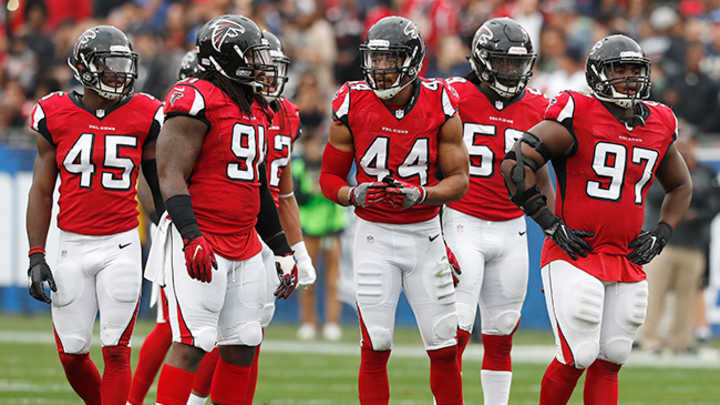Why the Falcons Should Attack Brady by Holding Back

When Tom Brady took the field for the first of his seven (and counting) Super Bowls 15 years ago, nine members of the current Falcons defense had yet to celebrate their 10th birthday.
This young Falcons D has earned the chance to face the living legend in Super Bowl 51 because they have improved markedly in head coach Dan Quinn’s scheme.
The more comfortable a defender is mentally within a scheme, the faster he can play. This is especially true with young players, and Quinn and GM Thomas Dimitroff had this in mind when constructing this Falcons D. Their four rookie starters—safety Keanu Neal, slot corner Brian Poole and linebackers Deion Jones and De’Vondre Campbell—plus last year’s first-round pick, Vic Beasley, offer high-end speed. Bill Belichick, in fact, has said this is the fastest defense he’s seen this season.
* * *
* * *
But a young, fast defense in and of itself doesn’t scare the Patriots. Brady just dismantled one in the AFC Championship, in fact. The Steelers have the same schematic foundation as the Falcons: a single-high zone, more commonly known as Cover 3. The Steelers play Cover 3 out of a slightly different structure, but within that structure, the matchups are the same.
And that’s the problem for Atlanta. No offense is better at exploiting zone matchups than the Patriots. They’re brilliant at working receivers against linebackers inside, both underneath and, as of lately, over the top. Which is why the Falcons, this Sunday, will do what the Steelers didn’t: eschew Cover 3 and play more man-to-man. Because faster play out of zone defense is one reason the Falcons are in the Super Bowl. Sound play out of man-to-man is the another. As the season has progressed, Quinn has called more man coverage, and with increasingly better results.

Man coverage’s jam and press techniques present your best chance at disrupting the timing of New England’s receivers. And that makes it your only chance at disrupting Tom Brady’s timing. The drawback is that New England’s system is great at tactically defeating man-to-man. The passing game is built on a bedrock of presnap motion; receivers at the snap working off the line together; and pick routes and crossing patterns. All are ploys that force man defenders to back off, less they risk colliding with other man defenders.
Quinn’s challenge is finding forms of man coverage that offset these drawbacks, and fortunately, he’s already found options here. In man coverage, you have five defenders responsible for each of the five eligible receivers. That leaves six defenders to scheme with. One of those defenders will be a deep middle safety (especially in Quinn’s system, where the middle of the field is always patrolled). So what do you do with those remaining five defenders?
Many teams will rush all five at the quarterback, creating a man-free blitz. The Falcons do this, but only occasionally. And defensive coordinators are reluctant to do it versus Brady because he gets the ball out before the blitz can arrive.
If the defense doesn’t blitz, chances are it rushes the standard four, which leaves one final defender to scheme with. Against north/south passing teams, it’s common to play that defender over the top, alongside the deep safety. But against the Patriots, who favor quick throws and crossing patterns, it makes sense to play him near the shallow middle of the field, as a “lurker.” The Falcons have made fruitful use of man-lurk coverage. Often Campbell is the lurker so that the more agile Neal can cover the tight end (in the Super Bowl, Martellus Bennett) and the speedier Jones can cover the running back (in this game it will likely be James White).
The Patriots are shrewd at shifting to formations that isolate matchups like “Neal vs. Bennett” and “Jones vs. White.” How these battles go could very well decide Super Bowl 51. Which is why we may see an added wrinkle from Quinn: Instead of rushing four, he could rush three, creating another free defender to accompany Campbell. This would do several things:
One: It virtually ensures that the middle of the field is always clogged, forcing Brady to throw outside, where he’s a little less comfortable. And if the throw goes outside, the sideline leaves less space for New England’s lethal run-after-catch.
Two: It presents the element of disguise out of man-to-man, which is rare. Usually with man-to-man, the quarterback sees things clearly: Defender A has Receiver A; Defender B has Receiver B; and so on. But with two unattached defenders roaming around, it’s possible for Defender A to switch to Receiver B after the snap, or for Defenders A and B to unexpectedly both take Receiver B. There can be a lot for the QB to process. This means a greater likelihood of the QB holding the ball, which diminishes the drawback of rushing only three. True, Brady has been great when forced to hold the ball this season, but you’re still picking the less lethal poison here. If Brady is holding the ball, the game is being played on your terms, not his.
Of course, blitzing is another way to make the quarterback play on your terms. This is what the Falcons unexpectedly did against Aaron Rodgers two weeks ago, and with great results. Rodgers, however, plays in a system less conducive to rhythmic quick strikes. Having had an extra week to get ready, it’s possible we’ll see Quinn pull out a never-before-seen plan and send pressure after Brady. But in football, you prepare for what’s likeliest to happen, not what could happen.
The Falcons are young and built on speed-aiding simplicity, not complex chicanery and disguise. The Patriots would be wise to prepare for the Falcons’ new staple man-to-man concepts, with the understanding that an extra free defender—or two—could be peppered into the coverage.
Question or comment? Email us at talkback@themmqb.com.
